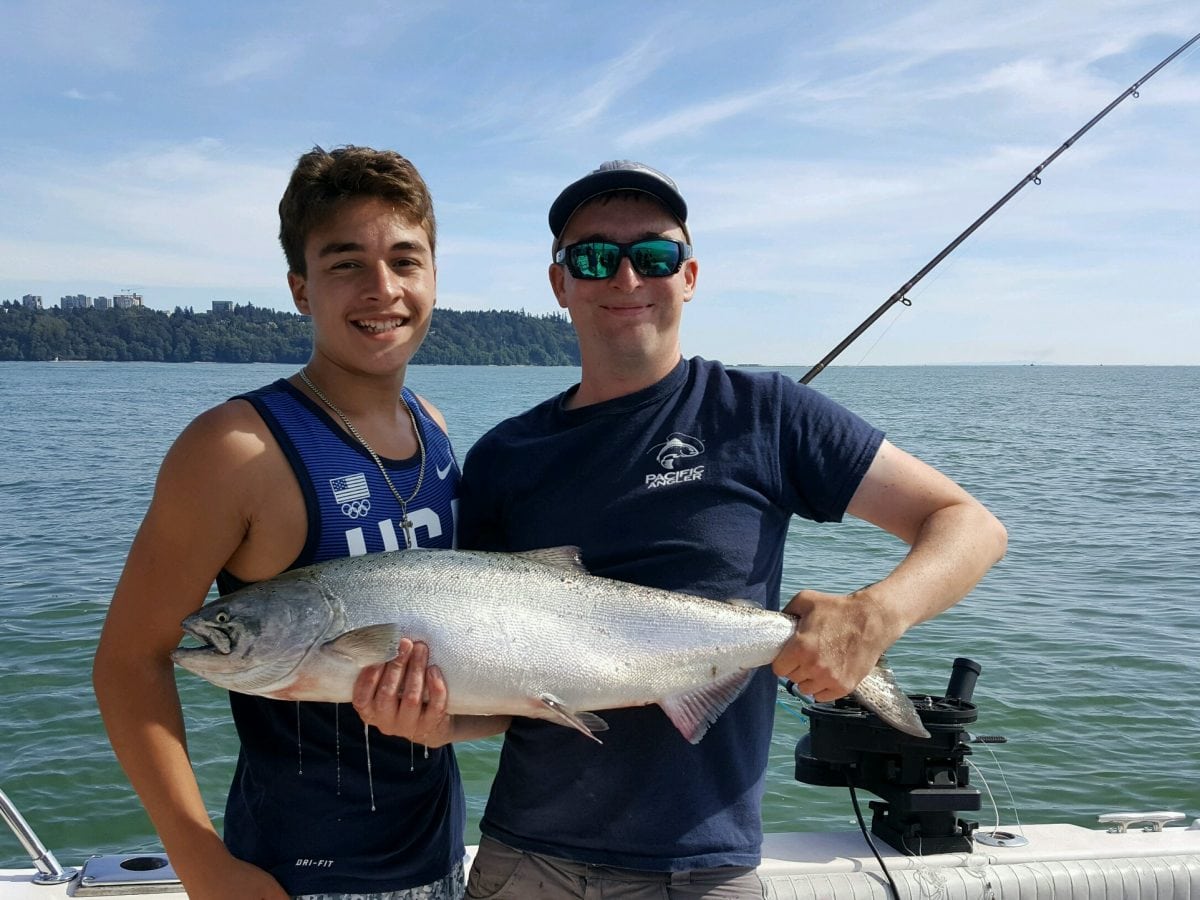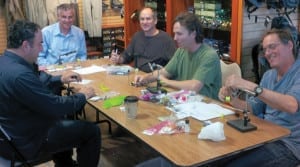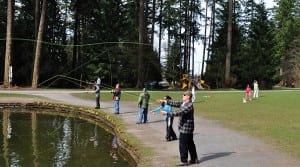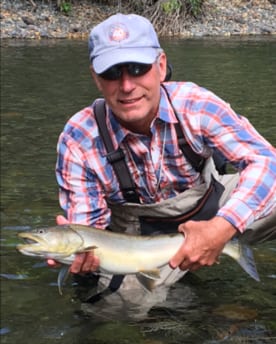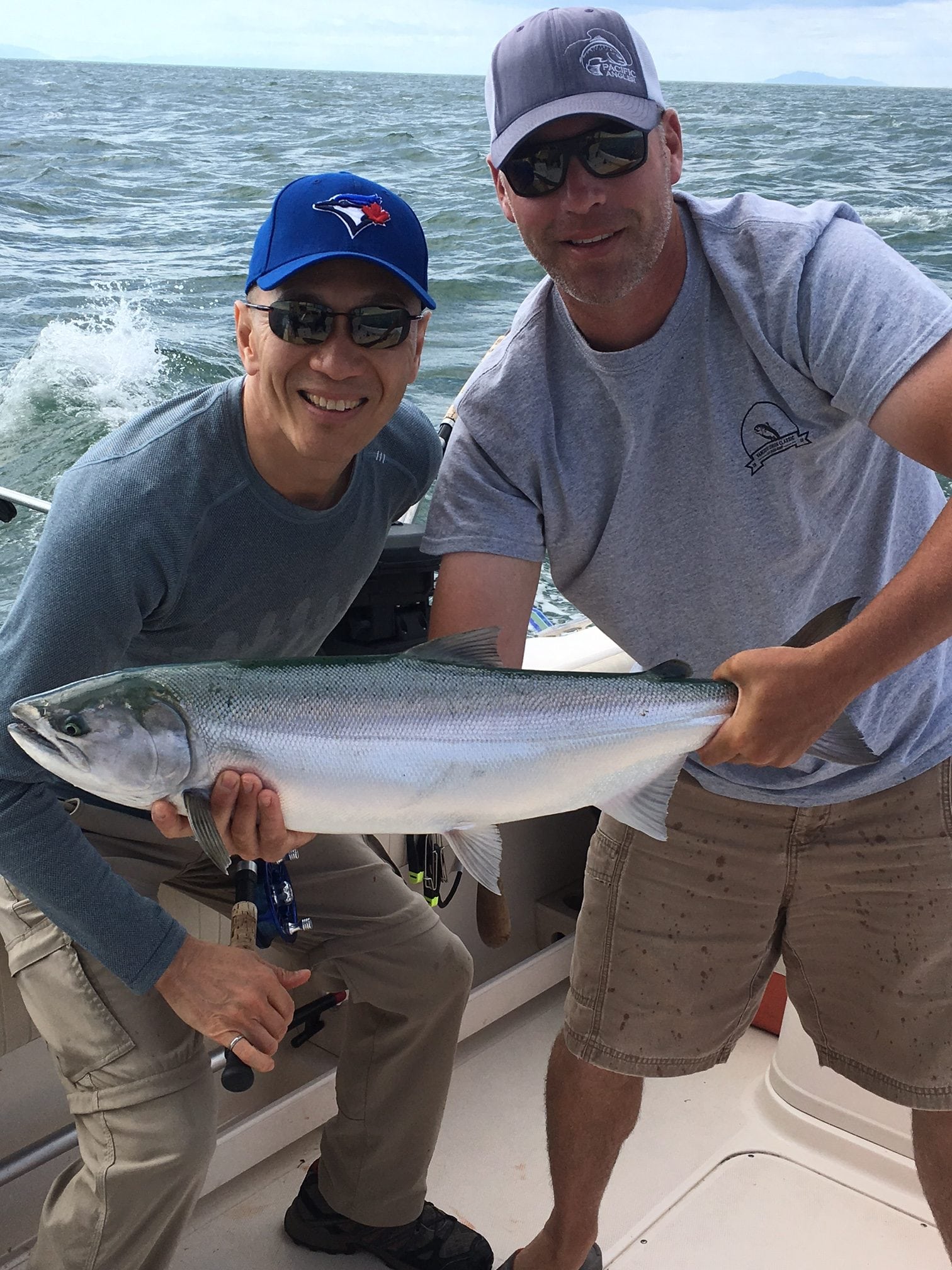OUTLOOK
September is here and with it we have updates on upcoming fisheries including a Vedder primer as well as some big shop news you won’t want to miss! We’ve also got an overview of some new products in stock just in time for the fall rain we’re seeing.
FALL SALMON SALE AT PACIFIC ANGLER
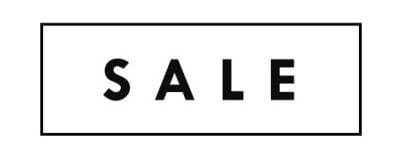 Fall is a great time to be a fisherman around Vancouver and we sometimes forget about it with the bustle to get kids back in school and getting back into work routines after the summer break. From as early as the second week of September into November the major runs of white chinook, coho, and chum salmon will be hitting our local waters. Lake fishing is awesome in September and the trout streams are also a great option as fish are fattening up for the winter. So we thought what better time to offer great savings to get you equipped for the next 3 months on the water!
Fall is a great time to be a fisherman around Vancouver and we sometimes forget about it with the bustle to get kids back in school and getting back into work routines after the summer break. From as early as the second week of September into November the major runs of white chinook, coho, and chum salmon will be hitting our local waters. Lake fishing is awesome in September and the trout streams are also a great option as fish are fattening up for the winter. So we thought what better time to offer great savings to get you equipped for the next 3 months on the water!
Mark the weekend of September 16th, 17th, and 18th on your calendars. EVERYTHING WILL BE ON SALE – with huge savings on waders, rods, reels, fly tying materials and saltwater gear. More details will be coming in the next several weeks so be sure to check your inboxes.
Enough about the sale, lets talk about the fishing. This week we have been seeing good fishing in the saltwater. Lots of chinook are hitting the docks and though it has not been as good as last year there are still some great fishing to be had. We’ve got more glow stick on eyes for all you guys experimenting with you teaser heads so come on down if you missed them and check out Jason’s saltwater report for more updates on the saltwater front.
We made a mistake in last week’s report saying that the Thompson is closed – it is not. For clarity full regulations are outlined in the report.
With salmon river fishing just around the corner Alex has a detailed report and ‘how to’ on fishing the Vedder river for salmon. The coho and chinook could show up any day and looking back at past guide journals we were catching fish by September 10 we are so its time to get out there, take a look and start tying leader boards and flies for the upcoming season.
Lake fishing is also starting to heat up and number of customers and friends are heading up to lake country. André has some tips on what to bring on a lake fall lake trip as well.
Lastly the Capilano beach fishery and river fishery have been a challenge this season but there have been some really big coho caught, more details on targeting these fish in the full reports below.
NEW PRODUCT – GRUNDENS RAIN GEAR
 The choice of professional commercial fishermen for over 100 years, developed in the North Seas of Scandinavia – Is it tough enough for the West Coast sports angler?
The choice of professional commercial fishermen for over 100 years, developed in the North Seas of Scandinavia – Is it tough enough for the West Coast sports angler?
We are extremely confident and excited that Grundens new sportfishing line is going to bring something to the market that local salmon anglers have been waiting for – commercial grade, high quality outerwear that will not break the bank.
In the fishing world high end Gore-Tex raingear holds top spot for comfort and functionality but for the guy that is on the water a ton and is no stranger to blood, guts, grease and saltwater, and doesn’t mind trading a little comfort for durability, Grundens Rain gear is going to be right up your alley. These tough pieces are a fraction of the price of Gore-Tex so you can’t go wrong. Our first shipment has arrived and we are fully stocked!
For those of you looking for a lightweight option the Gage bib pant and jacket are the way to go. This outfit is a 100% waterproof 420-denier nylon with fully taped and sealed seams and sports a breathability membrane. The jacket will run you $109.99 and the bib pants $179.99
The second model we are carrying is for the angler who wants durability and misses the good old days of rubber pants. The Neptune bib pant and jacket is tailored for active wear, using 230 g/m2 polyurethane-coated stretch polyester and heavy-duty RF welded seams throughout, combining 100% waterproof impermeability with superior ease of movement. Basically the bombproof durability of those good old rubber pants that lasted a decade with a few modern twists to gain some comfort. You can get into these for $129.99 for the jacket and $114.99 for the bibs.
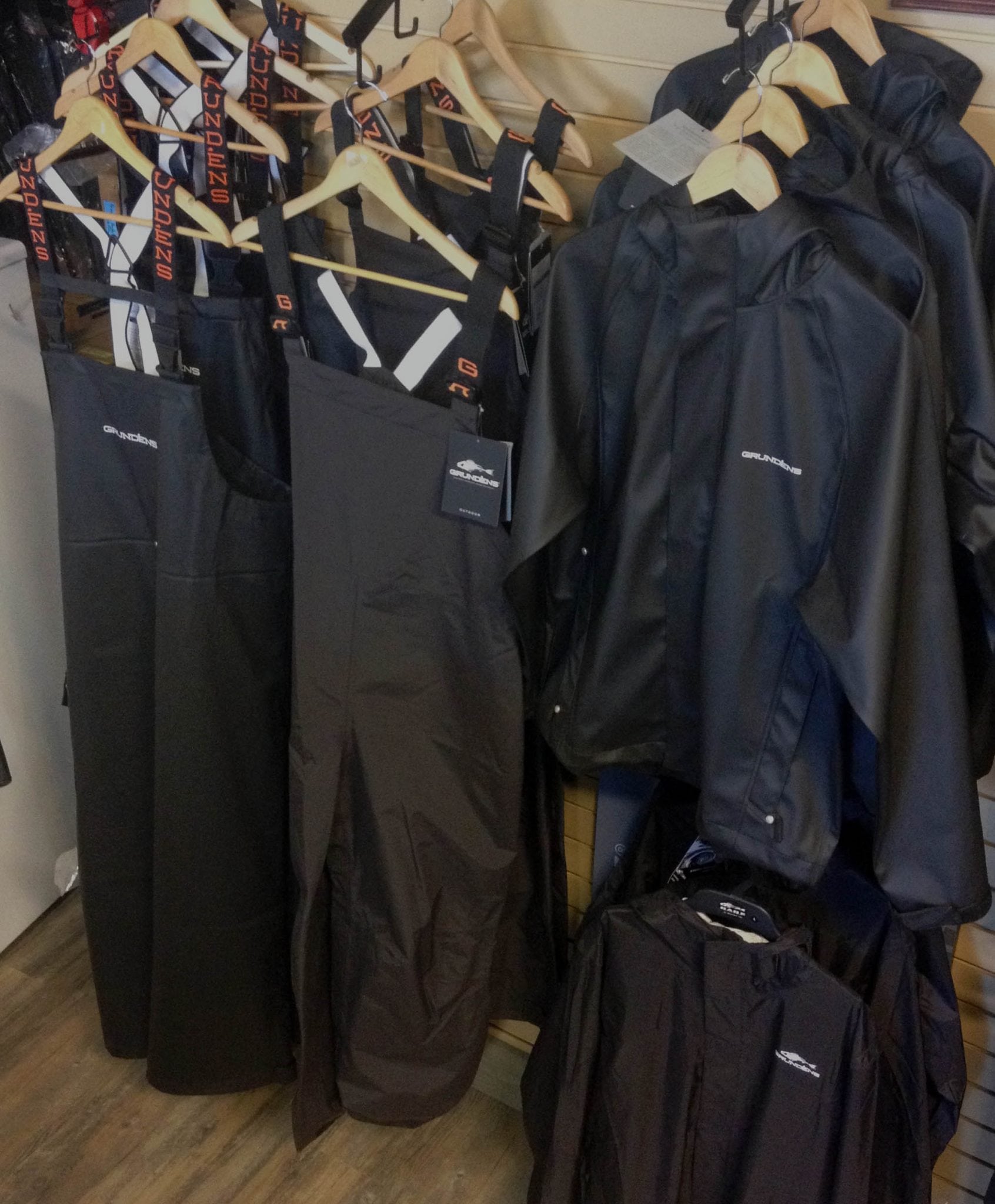 We are so confident in this gear that we are going to be equipping them on our guide boats this fall and even some of our lake fly guys are looking for a good cost effective boat pant and will be putting them through their passes on the lakes when things cool down in September.
We are so confident in this gear that we are going to be equipping them on our guide boats this fall and even some of our lake fly guys are looking for a good cost effective boat pant and will be putting them through their passes on the lakes when things cool down in September.
If you are in need of a boat pant or jacket that lives on the boat for that rainy day, come down and check them out.
CLASSES AND COURSES
Don’t let the kids be the only ones going back to school. Join us for our September Introductory Courses.
Introduction to Fly Tying
There is no greater satisfaction than catching a fish with a fly you tied yourself. This course was specifically designed to give you the fundamental skills needed to tie prone fly patters used here in BC for trout, salmon and steelhead. This course consists of 3 sessions; each season is 3 hours. Students are required to supply their own vice, looks and materials. A 10% discount is available on materials and tools purchased for the course.
Dates: September 20, 27 and October 4
Seminar Time: 6:30pm – 9:30pm
Cost: $75.00
Introduction to Fly Fishing
This course was specifically designed to give the new fly fisher the basic knowledge, casting skills and fly fishing strategies to effectively fish our local BC waters. This course is comprised of two sessions; 3hr evening seminar and a 3hr casting session.
Dates: Seminar September 21, Casting September 24
Seminar Time: 6:30pm – 9:30pm
Casting Time: 10am to 1pm or 2pm to 5pm
Cost: $125.00
FRESHWATER FISHING REPORTS
Vedder River Fishing Report – Coho Primer
Summer is almost over, but that doesn’t mean that the fun is ending. We got a taste of salmon fishing a month ago on the Vedder when the red chinook rolled in, and as we transition into the cooler part of the year it is the perfect time to prepare your tackle boxes, vests and fly boxes for the Salmon runs that are coming soon.
Not only is the Vedder one of the most popular rivers in the Lower Mainland, it is one of the most productive rivers. With strong runs of white chinook and chum salmon there is no shortage of large fish to hook. However, the coho salmon reigns supreme in terms of prestige and table fare among these fall runs. Starting in mid-September, the coho salmon will start showing up in the Vedder and the run will peak in the 3rd or 4th week of October depending on water conditions. They average 6-8lbs but specimens over 10lbs are not uncommon. What they may lack in size they make up for in spectacular aerial displays and crazy subsurface rolls when hooked. This fish has garnered a reputation for being difficult to catch at times but we’ve put together a guide that will give you the edge in finding and landing these silver bullets.
The first aspect to successfully catching a coho salmon is locating them. It is easy to get drawn in to the big runs where tons of huge fish are porpoising and other anglers are having success with chinook or chum salmon. While these runs may contain great water for holding fish, it will be extremely beneficial to avoid areas that are loaded with these bigger salmon as coho tend to get pushed out of this prime holding water. This is not to say that you will not catch coho in these locations; you will. However, you will most likely have to go through a number of chinook or chum before getting into any coho salmon. This can still be extremely fun, but isn’t good for those that want to selectively target this species. So where exactly do these fish reside? coho prefer to hold in slow moving water that has depth. Think of calmer tail-outs and pockets behind obstructions such as log jams or large boulders. Another very popular type of water for coho (and Coho fishers) is frog water. Frog water is defined as water with no current, which is usually, but not limited to, backwaters or side channels. This is where coho are likely to school up before moving upstream, and it can be an effective way to selectively target them. Frog water is sometimes the savior in blown out conditions as well as once the rains of late Fall comes the main stem is typically not fishable.
Once you’ve located the fish, what is the appropriate tackle to use? This is very situation-dependent but there are a number of options. One of the most popular methods is to drift pro-cured roe under a float such as a 25 gram DNE or Cleardrift, and this can be extremely deadly in low light conditions. With roe keep your hooks between size 4 and size 1, scaling it up in dirty water and scaling it down in clear water. Both Gamakatsu and Owner make fantastic octopus hooks for this application and they are extremely reliable for getting rock-solid hook sets. Other good choices for drifting are size 2 or 3 Colorado Blades (both Gibbs and Cleardrift products work well) or jigs, which can also be twitched. With these drifting setups focus on tail-outs of pools as well as walking speed water.
When it comes to more stagnant water, casting and retrieving lures are a better bet and there are quite a few different choices for that. A good place to start is with the Gibbs Koho spoons (45 and 55 sizes) as well as the Gibbs Crocs (3/16oz to ½ oz). These Fraser Valley Coho like blues and oranges, so focus on colours such as the Blue Illusion and Blue Scale for the Kohos and the Fire Stripe variations for the Crocs. Another good spoon to try is the K-3 Wobbler, both in straight nickel and the brass fire stripe. A good complement to any spoon is a spinner, and the Blue Fox Vibrax is the perfect match. A size 3 or 4 Vibrax in similar colours can trigger strikes when a spoon won’t and vice versa. All the aforementioned lures can also be swung through runs that have more current with great results.
A third option for frog water is to twitch jigs. While sticking with the known productive Coho colours such as a black and blue is always a safe bet, don’t be afraid to twitch brightly coloured jigs as well like a red on orange colour combination to trigger an aggression strike. Both Bent Rods Jigs and Maxi Jigs are well built and have a variety of colours to choose from.
When it comes to figuring out a rod and reel combo for Coho, there are a couple basic setups that cover the methods listed above. For drifting bait or artificials, a 10’6” medium power rod is standard for both baitcasting and centerpinning. The Trophy XL Titan 2106 (both baitcasting and centerpin models) is a fantastic light rod for coho as well as Steelhead later in the winter. For those that want to experience all of the fall salmon species that will be present in the Vedder, the Trophy XL Titan 3106 will be a better all-round rod. While these longer setups are good for picking up line off the water and achieving drag-free drifts, they do not excel in casting lures effectively. For this application, a shorter spinning or baitcasting rod in the 8-9’ range and medium-light to medium power is more ideal. There are a number of options in this range such as the Shimano Convergence, Fenwick Eagle, or Trophy XL Coho King.
When it comes to reels there is a huge selection to pick from but there are a couple that stand out. For spinning reels, an Okuma Epixor (40 size) or a Penn Fierce 3000 or 4000 are optimal sizes and great quality reels for the price, and if you want to beef it up for heavier applications and even better reliability a Penn Battle 3000 or 4000 will do the trick. For baitcasters, the Abu Garcia 6500 (or 6501 for the lefties out there) has long been considered the “entry level” king. At its price point it is the best bang for your buck level-wind out there with a fantastic reputation of being a general workhorse. For those that enjoy a more low-profile configuration but still need the line capacity, the Shimano Curado 300 fits that bill nicely. Last but certainly not least, the centerpin reels are a fantastic option for hardcore drifters. If you are in the market for an entry level centerpin, the Rapala R-Type will get you going without hurting the wallet. For those who are looking for a more refined single action reel, the Islander Steelheader and John Milner Kingfisher are outstanding reels and are well worth their praise.
Choosing the correct line for both your reel and your leader can be crucial to having a successful day and is dependent on a couple of factors. For the main line, 12-17lb monofilament will do the trick with Trilene for spinning reels and either Maxima or Big Game for level-winds and centerpins. If you choose to, you can also run braid in the 20-40lb range for your spinning or baitcasting reels. For your leaders it becomes a little more dependent on water clarity but a good standard is a 12lb fluorocarbon leader. Seaguar Blue Label is one of the best available. In extremely low and clear conditions you may go down to 8lb fluorocarbon if necessary, and on the opposite spectrum I have seen guys using up to 15lb Maxima when the water gets high.
Lastly we cannot forget the fly anglers. Coho and chum are an excellent fish to target with the fly and there are conditions when the fly angler can outperform the gear angler. Usually these are low light frog water scenarios (water that is not moving). One of the benefits of fly fishing is you can present a smaller offering in a very stealthy manner. When fish are picky, a small flash fly, muddler minnow or coho bugger on a sink tip or even a full intermediate line can be deadly. Again 8-12 lb fluorocarbon leaders are good and we can lengthen or shorten them to match water clarity. 5ft of 10lb fluorocarbon leader fished of a sink tip on a 6-8wt rod is perfect.
I hope this quick overview will help you achieve success with these magnificent fish. If you have any further questions please do not hesitate to contact us at the shop.
Tight Lines,
Alex
Capilano River Report
The rains this week may be what it takes to turn the tap on at the Capilano River. Watch the water levels; if the water rises then fishing can pick up at a moment’s notice as the coho staging at the mouth of the river will make their way to the hatchery. In the meantime, small spinners and spoons can entice a bite or two early in the morning. The current low water conditions can also be beneficial for fly fishermen as fishing small wooly buggers or streamers can be effective in the slow canyon pools where the fish are staging. Besides the traditional flies we also have a selection of Capilano-specific flies tied by Andre.
If the water rises, drift fishing will become a viable option. Please remember that there is a bait ban in effect until October 31st, so if you do plan to drift fish use non-scented artificial baits or lures.
Skagit River Fishing Report
We had another week of good Skagit reports. This rain will probably raise the river and make things a little harder to access but because the river has been low it may not have too much of an adverse affect on the fishing. It is also a little hard to predict weather in the Skagit Valley. Hope is the obvious weather report to look at but the weather systems hitting the Skagit can be completely different than what is happening in Hope. I usually look at weather reports from just over the border and compare them to the Hope report.
Obviously fishing in the rain can be a challenge on the Skagit because the rain hampers hatches. That said nymphing can be excellent in these conditions and when there are brakes in the rain hatches can come on hard and heavy.
We had reports of green mayflies coming off in the last week as well as larger grey drakes and the usual small grey mayflies. We also had some customers fishing small black dry flies with good success. As I say every week there is no one hot fly. Every day is a little different and this is what I like about the Skagit. You will need to search, hike and experiment. Over a few trips, a few seasons or even better a few decades you will build a diverse selection of “favorite” flies that you can apply to different situations. For me the standards are a prince nymph variant, small golden stone, double bead hares ear, and an olive small stonefly nymph. For dries I fishing a large grey drake, small grey mayfly, a very small dark dry fly, finally a very small yellow caddis pattern and if all else fails an orange or yellow stimulator. We just got in another shipment of Skagit flies, so we should have all the staples for your next trip up.
More bulltrout are also being caught and for me white streamers and olive streamers in different weights and sizes make up the go to patterns but purple, maroon and black options are also in the arsenal and have entices picky fish to take.
Good Luck and I would love to hear how the weather affects the river. I am heading up next week.
Matt
Thompson River Fishing Report
Well this is embarrassing. I made a glaring mistake in last week’s report. The Thompson River does not close September 1. Apologies for any confusion, I don’t know how I got my wires crossed. Maybe I subconsciously wanted it to be closed so I could stop torturing myself trying to find a way to sneak up there this season. Below are the exact regulations related to the Thompson River.
Historically the trout fishing has been limited in September because of the salmon. Large schools of sockeye scare off the trout and the ones that are feeding start focusing on eggs farther up the system. This year with low sockeye numbers we could see an excellent late trout season. If I were heading up I’d definitely have hopper and stone fly patterns along with a few egg patterns or beads in my arsenal.
Good luck out there and again my apologies for the mistake in last week’s report.
Matt
Thompson River Regulations
Downstream of signs at Kamloops Lake outlet to the confluence with Fraser River 3-13 3-14 3-18
No Fishing Nov 1-May 31
Check website www.env.gov.bc.ca/fw/fish/regulations for possible season extension
No hooks greater than 15mm from point to shank, Oct 1-Dec 31; Trout/char daily quota = 2 (none under 35 cm)
Special additional opening from the CNR Bridge downstream of Deadman River to CNR Bridge upstream of Bonaparte River, May 1-31; trout/char release and artificial fly only, May 1-31
- From boundary signs 1 km downstream of Martel to the confluence with the Fraser River; bait ban Oct 1-Dec 31 Upstream of boundary signs 1 km downstream of Martel: Bait Ban
- No angling from boats
- Downstream of signs at Kamloops Lake: Class II water Oct 1-Dec 31 and Steelhead stamp mandatory Oct 1-Dec 31 (when open)
STILLWATER FISHING REPORTS
Interior Lake fishing Report
As we approach fall and the temperatures cool down its time to start thinking about lake fishing. If you’re heading to the interior the main staples to have in your box are big leeches, dragonfly nymphs, scuds, and water boatman.
The key is to find were the thermocline is and try to keep the fly in that zone and you should get some aggressive strikes. For deeper water I like to use a full sink line with 6ft of 6-8lb tippet. If the fish are in shallow, you can use a floating line with a strike indicator to suspend the fly at the desired depth. Indicator fishing with both leeches and scuds is a popular method in the fall months. Fish will often forage in shallow water as they fatten up for the winter, making for some excellent sight fishing opportunities.
SALTWATER FISHING REPORTS
North Vancouver Beach Fishing Report
Not much has changed from the last report in term of numbers of fish. A few customers had some hook ups with the good tides last week so that’s great news. The tides are going to be good again from September 10th onwards and it is also my favourite time to fish the beach as there is a certain calmness in the fall and the fish are bigger in size. The chinook are going to accumulate around the Capilano river mouth and wait for the first big down pour before they head up to the hatchery so be ready if you encounter one of these brutes as they could rip the rod out of your hand.
Andre
Vancouver Saltwater Fishing Report
The whale watching boats have sure had a good week, the chinook anglers not so much. There seems to be orcas working the North Arm to the South Arm of the Fraser pretty much every other day with numerous pods spotted all week. Without a doubt this affects the chinook fishing and as a result we have had some lackluster days in-between some good days. As mentioned in last week’s report, if you are out there when a school of chinook shows up on the flood tide off the Fraser mouth area and the whales aren’t around, then fishing has been pretty good. Then of course there are the seals, they have been aggressive this year and have taken a number of fish from our boats this past week. Despite the orcas and the seals, there have been some nice chinook caught and we are starting to see some big ones. For the most part we are still getting the red springs in the 10 to 20 pound class but more and more of the white springs are starting to show up. This trend will continue as more whites show up in the first week or two of September and the red springs finish off for the year. These white springs are generally headed for the Harrison River and Chilliwack/Vedder River. There are plenty of 30 plus pound fish that enter these rivers each fall so if you want your shot at a local tyee, now is the time to start fishing the T-10 and South Arm for these fish. We don’t seem to get as many of them off the North Arm or Bell Buoy as most of them seem to head up the South Arm, so if you have the time to book a longer charter, or the winds allow the run down S, this is what we recommend for the next 2 weeks.
Productive depths on the downriggers for chinook in the Bell Buoy, North Arm, T-10, and South Arm have been 30-80 with the 60-70 zone being the best lately. As usual, bait has been the most productive. A mix of herring or anchovies in a glow teaser head with some green, chartreuse or blue has been producing. For more information on flashers and teaser head choices, visit last week’s report where I went in depth on this subject and provided pictures as well.
On our shallower rods we have been hitting some nice coho. The coho along the entire coast seem to be above average size this year. There aren’t a lot, so it doesn’t look like it will be a banner fall for coho, but the ones we are getting are in extremely good shape and big! There have been a mix of hatchery and wild coho and expect to see more of coho show up next week as the numbers always build throughout September.
It has also been good to see Department of Fisheries Conservation & Protection staff out these past weeks. They have been out in the zodiac patrolling all the local fishing spots, in particular the North Arm to South Arm area, so make sure you are outside of the closed area, your barbs are pinched, and you are fishing for chinook and hatchery coho. All wild coho and sockeye must be released with care.
See you in the shop or on the water,
Jason Tonelli


